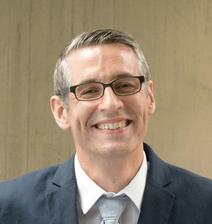Martin Burger is setting up the new Computational Imaging group at DESY. (Credit: private photo of Martin Burger)
The DESY Photon Science division is welcoming a new lead scientist to its ranks: the Austrian Martin Burger is setting up the Computational Imaging group, with which he hopes to improve the reconstruction and analysis of the scientific images recorded during the many experiments carried out at DESY and other research centres. Burger’s team also forms a research unit of the platform Helmholtz Imaging, which DESY operates together with the Helmholtz Centres DKFZ and MDC.
Martin Burger knows all about images – and especially about poor image data. He wants to turn noisy measurements into good pictures, in other words to tease out as much valuable information as possible from them. Coming from the field of applied mathematics, he does this by using mathematical models and algorithms to facilitate the reconstruction of the images from the data.
Burger compares his work to a scene from a typical crime thriller: a crime has been captured by a surveillance camera, but the camera’s resolution is too poor and there is too much noise to be able to read the number plate or identify a face. Enter Burger, with his mathematical tools: “Each image on its own cannot resolve the number plate; but we can take advantage of the fact that the images taken by the camera are connected with each other. And by looking at the entire sequence and using their connection, you can extract additional information, possibly making the number plate legible.” Translated to the field of science, this means using information that is not available at first glance to improve the resolution or informational value of the images. The images don’t really have to be “bad”, of course, but they may still contain hidden information or dimensions that Burger can coax from them with the help of mathematics. The key lies in solving so-called inverse problems. “In doing so, you are reversing the natural solution process,” explains Burger. You are working backwards from the effect to the cause, so to speak. “Inverse problems are much more exciting than normal ones, but also much more difficult to solve,” says Burger with a smile.
The images that Burger improves are extremely varied in terms of their source and content. In his previous jobs as a professor at the Universities of Münster and Erlangen, it was often biomedical images for which he developed optimisation methods, for example images of moving organs in the Cluster of Excellence “Cells in Motion”. But the methods available to him for using images efficiently can also be applied to data from radiation sensors for low-level radioactivity, which are used when dismantling nuclear power plants, or from Mars probes, whose images can only be transmitted within a small bandwidth. “Quite often, the methods used to reconstruct the images can be applied across a wide range of scales – from microscopy to astrophysics,” says Burger. What is always important to him is having an insight into many different research areas, working together at an interdisciplinary level.
As the first professor to be appointed jointly with the Department of Mathematics at the University of Hamburg, he wants to take images from PETRA III and the X-ray lasers at DESY, for example, and try to extract good 3D information from the various two-dimensional diffraction data of the tiny objects under investigation, i.e. to improve the reconstruction of tomographic applications. In addition to this reconstruction, another important aspect is quantifying uncertainties; he and his team want to develop new mathematical methods for this. And Martin Burger will also play an important role in the transition to PETRA IV, a future project currently in the planning stage – here he intends to develop algorithms for compressing the data, preferably without jeopardising the information, in order to cope with the expected flood of data.
(from DESY News)







